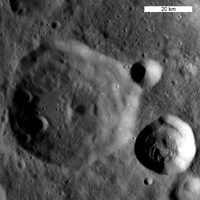
|
Dante Crater Constellation Region of Interest
- Click the image above for a larger view
- Full-Res JPEG (1000 x 1000) (167.2 kB)
- Full-Res TIFF (1000 x 1000) (1.0 MB)
Caption:

Figure 1
Click on the image for larger version
Highlands terrain inside the Dante Crater Constellation Site . A portion of LROC NAC image M121044107R, 580 m across. The Dante region has abundant aluminum and calcium-rich regolith that is available for in-situ resource utilization, allowing explorers to extend their stay in this region by processing the local materials to produce oxygen and fuel while building habitats and other structures.
Figure 1: Portion of LROC WAC image M118668951M, which covers Dante Crater itself. The region of M121044107R (main image) is to the west of this scene.
Background Info:
NASA's Goddard Space Flight Center built and manages the mission for the Exploration Systems Mission Directorate at NASA Headquarters in Washington. The Lunar Reconnaissance Orbiter Camera was designed to acquire data for landing site certification and to conduct polar illumination studies and global mapping. Operated by Arizona State University, LROC consists of a pair of narrow-angle cameras (NAC) and a single wide-angle camera (WAC). The mission is expected to return over 70 terabytes of image data.
Cataloging Keywords:
| Name | Value | Additional Values |
|---|---|---|
| Target | Moon | |
| System | Earth | |
| Target Type | Satellite | |
| Mission | Lunar Reconnaissance Orbiter (LRO) | |
| Instrument Host | Lunar Reconnaissance Orbiter | |
| Host Type | Orbiter | |
| Instrument | Lunar Reconnaissance Orbiter Camera (NAC) | |
| Detector | Narrow Angle Camera (NAC), Wide Angle Camera (WAC) | |
| Extra Keywords | Crater, Grayscale | |
| Acquisition Date | ||
| Release Date | 2010-04-21 | |
| Date in Caption | ||
| Image Credit | NASA/GSFC/Arizona State University | |
| Source | photojournal.jpl.nasa.gov/catalog/PIA13059 | |
| Identifier | PIA13059 | |
